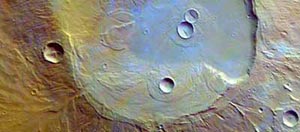Ancient caldera in Apollinaris Patera

Apollinaris Patera is an ancient shield volcano measuring approximately 180 by 280 kilometres at its base and rising to a maximum of 5 kilometres above the surrounding terrain. Shield volcanos are large volcanic structures with gently sloping flanks. The caldera of Apollinaris Patera takes the form of a large crater approximately 80 kilometres in diameter. In this false-colour image, north is to the right. The image also shows the terrain partly covered by thin, diffuse clouds indicated by bluish-tinted areas. This false-colour image was captured on 26 October 2004 by the High-Resolution Stereo Camera (HRSC) onboard the ESA spacecraft Mars Express with a ground resolution of approximately 11.1 metres per pixel. Credits: ESA/DLR/FU Berlin (G. Neukum)
The HRSC obtained these images during orbit 987 with a ground resolution of approximately 11.1 metres per pixel. The images show part of Apollinaris Patera, a volcano lying at approximately 7.2° South and 174.6° East.
Apollinaris Patera is an ancient shield volcano located at the northern edge of the Southern Highlands, lying to the south-east of Elysium Planitia and to the north of Gusev Crater, which is now being explored by NASA's Mars Rover, Spirit.
The volcano measures approximately 180 by 280 kilometres at its base and rises to a maximum of 5 kilometres above the surrounding terrain.
Shield volcanos are large volcanic structures with gently sloping flanks. The caldera of Apollinaris Patera takes the form of a large crater approximately 80 kilometres in diameter and up to 1 kilometre deep. Volcanic calderas are formed when a volcano explodes or when the cone collapses.
In the true-colour image, the terrain is partly covered by thin, diffuse, whitish-appearing clouds. In the false-colour image, the clouds appear as bluish-tinted areas.
The western region of the colour image (top of the image, as north is to the right) is characterized by brighter material, which seems to be layered and could be the result of sedimentary deposition. Distinct layering, causing a terrace-like appearance, is also visible east of this brighter material and in the relatively flat region located in the northwest (top right) of the colour image.
The colour scenes have been derived from the three HRSC-colour channels and the nadir channel. The anaglyph image was calculated from the nadir and one stereo channel. Image resolution has been decreased for use on the internet.
Media Contact
More Information:
http://www.esa.int/SPECIALS/Mars_Express/SEM412AATME_0.htmlAll latest news from the category: Physics and Astronomy
This area deals with the fundamental laws and building blocks of nature and how they interact, the properties and the behavior of matter, and research into space and time and their structures.
innovations-report provides in-depth reports and articles on subjects such as astrophysics, laser technologies, nuclear, quantum, particle and solid-state physics, nanotechnologies, planetary research and findings (Mars, Venus) and developments related to the Hubble Telescope.
Newest articles

Superradiant atoms could push the boundaries of how precisely time can be measured
Superradiant atoms can help us measure time more precisely than ever. In a new study, researchers from the University of Copenhagen present a new method for measuring the time interval,…

Ion thermoelectric conversion devices for near room temperature
The electrode sheet of the thermoelectric device consists of ionic hydrogel, which is sandwiched between the electrodes to form, and the Prussian blue on the electrode undergoes a redox reaction…

Zap Energy achieves 37-million-degree temperatures in a compact device
New publication reports record electron temperatures for a small-scale, sheared-flow-stabilized Z-pinch fusion device. In the nine decades since humans first produced fusion reactions, only a few fusion technologies have demonstrated…





















